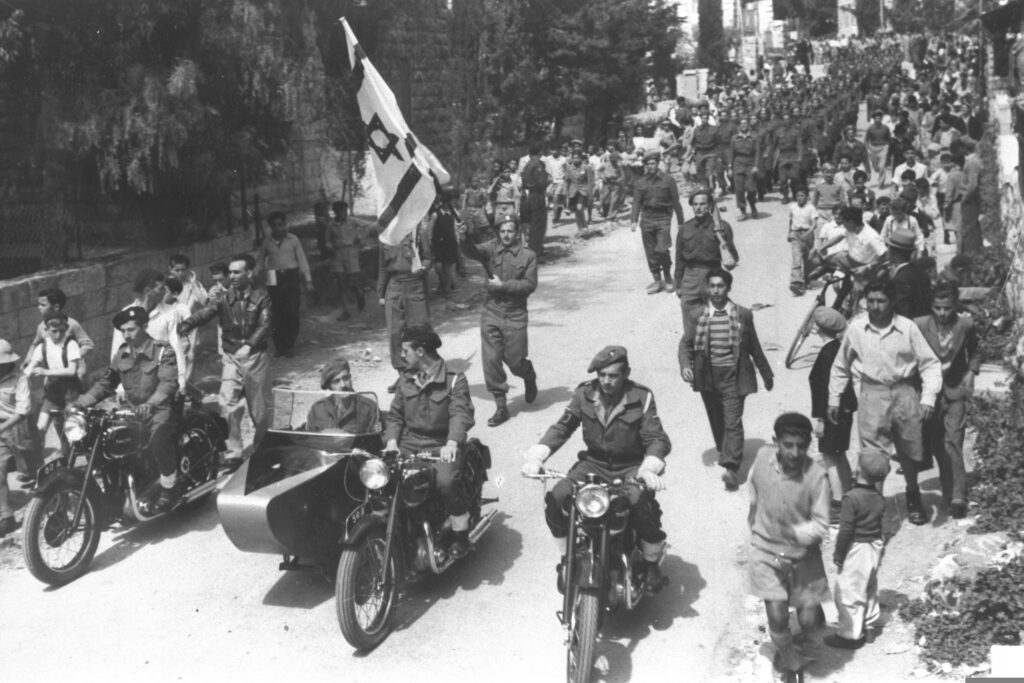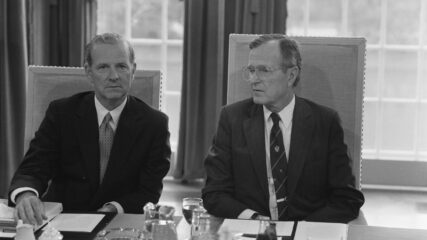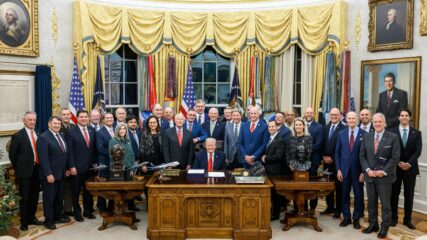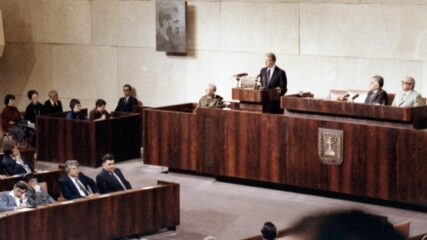August 1, 2025
CIE has compiled the following list of books and articles, including some available on our website, to guide understanding of Israel’s military operations through the Israel Defense Forces and the pre-state Haganah.
Books
Allon, Yigal. The Making of Israel’s Army. New York: Universe Books, 1970.
Aron, Wellesley. Wheels in the Storm: The Genesis of the Israeli Defense Force. Australia: A Roebuck Book, 1974.
Bar-On, Mordechai. A Never-Ending Conflict: A Guide to Israeli Military History. Westport, CT: Praeger, 2004.
Bar-Siman-Tov, Yaacov. The Israeli-Egyptian War of Attrition 1969-1970. New York: Columbia University Press, 1980.
Bar-Zohar, Michael, and Nissim Mishal. Mossad: The Greatest Missions of the Israeli Secret Service. New York: HarperCollins, 2012.
Begin, Menachem. The Revolt. New York: Nash Publishing, 1977.
Bell, J. Bowyer. Terror out of Zion: The Fight for Israeli Independence, 1929-1949, Irgun Zvai Leumi, LEHI and the Palestine Underground. Dublin: Academy Press, 1979.
Ben-Ami, Yitshaq. Years of Wrath, Days of Glory: Memoirs From the Irgun. New York: Shengold Publishers, 1983.
Ben-Horin, Yoav and Barry Posen, Israel’s Strategic Doctrine, Rand Corporation, 1981.
Bergman, Ronen, and Ronnie Hope. Rise and Kill First: The Secret History of Israel’s Targeted Assassinations. New York: Random House, 2018.
Black, Ian, and Benny Morris. Israel’s Secret Wars: A History of Israel’s Intelligence Services. New York: Grove Weidenfeld, 1991.
Brom, Shlomo, and Meir Elran (eds.). The Second Lebanon War: Strategic Perspectives. Tel Aviv: Institute for National Security Studies, 2007.
Byman, Daniel. A High Price: The Triumphs and Failures of Israeli Counterterrorism. New York: Oxford University Press, 2011.
Center for Israel Education. The June 1967 War: How It Changed Jewish, Israeli and Middle Eastern History. Atlanta, 2017.
Center for Israel Education. “Origins of the Arab-Israeli Conflict, Pre-State to 1973.” On-demand course, 2024.
Center for Israel Education. “Arab-Israeli Conflict: Quest for Normalization, 1973-Present.” On-demand course, 2024.
Childer, Erskine B. The Road to Suez. London: Maggibon and Kee, 1962.
Cohen, Eliezer. Israel’s Best Defense: The First Full Story of the Israeli Air Force. New York: Orion, 1993.
Cohen, Eliot A., Michael J. Eisenstadt and Andrew J. Bacevich, ‘Knives, Tanks, and Missiles’: Israel’s Security Revolution, Washington Institute for Near East Policy, Washington DC, 1998.
Drory, Zeʼev. The Israel Defense Force and the Foundation of Israel: Utopia in Uniform. London: Taylor & Francis, 2005.
Dupuy, Trevor N. Elusive Victory The Arab-Israeli Wars 1947-1974, Military Book Clubs, 2002
Finer, Herman. Dulles Over Suez the Theory and Practice of His Diplomacy. London: Heinemann, 1964.
Finkel, Meir. Studies in Generalship: Lessons From the Chiefs of Staff of the Israel Defense Forces. Stanford, CA: Hoover Institution Press, Stanford University, 2021.
Flapan, Simha. The Birth of Israel: Myths and Realities. New York: Pantheon Books, 1987.
Franzman, Seth. “The IDF in Gaza: “Gideon’s Chariots” Making Slow Progress,” The Jerusalem Strategic Tribune, June 2025.
Gewirtz, Jason. Israel’s Edge: The Story of the IDF’s Most Elite Unit — Talpiot. Jerusalem: Gefen House, 2016.
Golan, Zev. Free Jerusalem: Heroes, Heroines and Rogues Who Created the State of Israel. Devora Publishing, 2003.
Golan, Zev. Stern: The Man and His Gang. Tel Aviv: Yair Publishing, 2011.
Goldstein, Jacob. From Fighters to Soldiers: How the Israeli Defense Forces Began. Portland, OR: Sussex Academic, 1998.
Halevy, Efraim. Man in the Shadows: Inside the Middle East Crisis With a Man Who Led the Mossad. New York: St. Martin’s Press, 2006.
Harel, Amos, and Avi Issachararoff. 34 Days: Israel, Hezbollah, and the War in Lebanon. New York: Palgrave MacMillan, 2007.
Heller, Joseph. The Stern Gang: Ideology, Politics, and Terror, 1940-1949. London: Frank Cass, 1995.
Hurewitz, J.C. The Struggle for Palestine. New York: W.W. Norton, 1950.
Israel State Archives. The Yom Kippur War, October 1973.
Jonas, George. Vengeance: The True Story of an Israeli Counter-Terrorist Team. New York: Simon & Schuster, 1984.
Katz, Emmanuel. Lechi; Fighters for the Freedom of Israel (F.F.I). Tel Aviv: Yair, 1987.
Katz, Samuel M. The Elite: The True Story of Israel’s Secret Counterterrorist Unit. New York: Pocket Books, 1992.
Katz, Shmuel. Days of Fire. New York: Doubleday, 1968.
Katz, Samuel M. The Ghost Warriors: Inside Israel’s Undercover War Against Suicide Terrorism. New York: Berkley Caliber, 2016.
Katz, Yaakov, and Amir Bohbot. The Weapon Wizards: How Israel Became a High-Tech Military Superpower. New York: St. Martin’s, 2017.
Klein, Aaron J. Striking Back: The 1972 Munich Olympics Massacre and Israel’s Deadly Response. New York: Random House, 2007.
Klieman, Aharon, and Reuven Pedatzur. Rearming Israel: Defense Procurement Through the 1990s. New York: Routledge, 2019.
Korboński, Stefan. Unknown Chapter in the Life of Menachem Begin and Irgun Zvai Leumi. Colorado, 1979.
Korn, David. Stalemate: The War of Attrition and Great Power Diplomacy in the Middle East, 1967-1970. Boulder, CO: Westview Press, 1992.
Levite, Ariel. Offense and Defense in Israeli Military Doctrine. New York: Routledge, 2018.
Love, Kennett. Suez: The Twice-Fought War. New York: McGraw Hill, 1969.
Lloyd, Selwyn. Suez 1956: A Personal Account. New York: Mayflower Books, 1978.
Luttwak, Edward and Daniel Horowtiz, The Israeli Army: 1948-1973, 1975.
Luttwak, Edward, and Eitan Shamir. The Art of Military Innovation: Lessons From the Israel Defense Forces. Cambridge, MA: Harvard University Press, 2023.
Marshall, S.L. A Sinai Victory: Command Decisions in History’s Shortest War, Israel’s Hundred-Hour Conquest of Egypt East of Suez, Autumn 1956. New York: William Morrow and Co., 1958.
Nutting, Anthony. No End of a Lesson: The Story of Suez. London: Constable and Co, 1967.
Oren, Michael B. The Origins of the Second Arab-Israeli War: Egypt, Israel and the Great Powers, 1952-1956. London: Frank Cass, 1992.
Ostrovsky, Victor, and Claire Hoy. By Way of Deception: The Making and Unmaking of a Mossad Officer. New York: St. Martin’s Press, 1990.
Rabinovich, Itamar. The War for Lebanon 1970-1983. Ithaca, NY: Cornell University Press, 1984.
Raviv, Dan, and Yossi Melman. Every Spy a Prince: The Complete History of Israel’s Intelligence Community. Boston: Houghton Mifflin, 1990.
Raviv, Dan, and Yossi Melman. Spies Against Armageddon: Inside Israel’s Secret Wars. New York: Levant Books, 2012.
Rosman-Stollman, Elisheva. For God and Country? Religious Student-Soldiers in the Israel Defense Forces. Center for Middle East Studies, 2015.
Schiff, Ze’ev, and Ehud Ya’ari. Israel’s Lebanon War. New York: Simon & Schuster, 1984.
Shapira, Anita. Land and Power: The Zionist Resort to Force, 1881-1948. Stanford, CA: Stanford University Press, 1999.
Thomas, Gordon. Gideon’s Spies: The Secret History of the Mossad. New York: St. Martin’s Griffin, 2000.
Troen, S.I., and M. Shemesh. The Suez- Sinai Crisis 1956: Retrospective and Reappraisal. New York: Columbia University Press, 1990.
Williams, Louis. Military Aspects of the Israeli-Arab Conflict. New York: Routledge, 1975.
Yingst, Trey. Black Saturday: An Unfiltered Account of the October 7th Attack on Israel and the War in Gaza. New York: Fox News Books, 2024.
Articles
Alon, Nitsan, “Operational Challenges in Ground Operations in Urban Areas: An IDF Perspective,” Vanderbilt Journal of Transnational Law 51, 3 (2018): 737-762.
Baram, Gil, “Israeli Defense in the Age of Cyber War,” Middle East Quarterly (Winter 2017): 1-10.
Baruch, Sharvit, “Opening All Combat Positions in the IDF to Women,” Institute for National Security Studies (2019).
Bauer, Yehuda, “From Cooperation to Resistance: The Haganah 1938-1946,” Middle Eastern Studies 2, 3 (April 1966): 182-210.
Ben-Shalom, Uzi, and Yizhaq Benbenisty, “‘A Time of War’: Contextual and Organisational Dimensions in the Construction of Combat Motivation in the IDF,” Journal of Strategic Studies 42, 3-4 (June 2019): 371-394.
Ben-Shalom, Uzi, Eyal Lewin, and Shimrit Engel, “Organizational Processes and Gender Integration in Operational Military Units: An Israel Defense Forces Case Study,” Gender, Work & Organization 26, 9 (September 2019): 1289-1303.
Ben-Shalom, Uzi, and Yuval Tsur, “Scripts of Service Culture and Joint Operations of Air and Ground Forces: An IDF Case Study,” Israel Affairs 24, 1 (February 2018): 84-98.
Brenner, Y.S., “The ‘Stern Gang’ 1940-48,” Middle Eastern Studies 2, 1 (October 1965): 2-30.
Center for Israel Education, “Reasoned Views for Palestinian Arabs’ Dysfunctional Condition, 1945-1949,” April 2023.
Cohen, Amichai, and Stuart Cohen, “The Dynamics of Israel’s National Security Constitution since 1948,” Israel Studies 23, 3 (2018): 180-188.
Cohen, Stuart A., “The Israel Defense Forces: From a ‘People’s Army’ to a ‘Professional Military’ — Causes and Implications,” Armed Forces & Society 21, 2 (1995): 237-254.
Cohen, Stuart A., and Efraim Inbar, “Varieties of Counter-Insurgency Activities: Israel’s Military Operations Against the Palestinians 1948-90,” Small Wars and Insurgencies 2, 1 (April 1991): 41-60.
Dinitz, Simcha, Ken Stein Interview with the former Israeli ambassador to the United States, addressing military resupply, Center for Israel Education, Jerusalem (March 20, 1992).
Eisenkot, Gadi, and Gabi Siboni, “Guidelines for Israel’s National Security Strategy,” Washington Institute for Near East Policy (October 2, 2019).
Elam, Yigal, “Haganah, Irgun and ‘Stern’: Who Did What?” Jerusalem Quarterly, 23 (Spring 1982): 70-78.
El-Gamasy, Gen. Mohamed Abdel Ghani, Ken Stein interview with the Egyptian chief of staff in the 1973 war and later peace negotiator, Center for Israel Education (November 10, 1992).
Even, Shmuel, and Sasson Hadad, “Is the IDF Ready for War?” Institute for National Security Studies (March 25, 2019).
Goldberg, Giora, “Haganah, Irgun and ‘Stern’: Who Did What?” Jerusalem Quarterly, 25 (Fall 1982): 116-120.
HaCohen, David, “Smuggling Arms for the Hagana,” Jerusalem Quarterly, 9 (Fall 1978): 55-63.
Harlap, Shmuel, “Is the IDF the Most Moral Military in the World?” Institute for National Security Studies (September 4, 2023).
Hazut, Aviad, and Ofer Shelah, “The IDF Ground Operation in Lebanon — Goals, Alternatives, and Implementation,” Institute for National Security Studies (November 2024).
Heimann, Ariel, “Salaries, Compensation, and Benefits in the IDF: Implications for the Defense Budget,” Institute for National Security Studies (January 2022).
Horowitz, Dan, “The Israeli Concept of National Security,” in Avner Yaniv (ed.), National Security and Democracy in Israel, Boulder, CO, Lynne Rienner Publishers Inc. (1993): 11-53.
Hussein, Ahmed Qasem, “The Evolution of the Military Action of the Izz Al-Din al-Qassam Brigades: How Hamas Established Its Army in Gaza,” AlMuntaqa 4, No. 1 (2021): 78-97.
Inbar, Efraim, “Israel’s Small War: Military Response to the Intifada,” Armed Forces and Society (Fall 1991): 29-50.
Jager, Avi, “The Transformation of the Israel Defense Forces,” Naval War College Review 74, No. 2 (2021): 13-36.
Kalisky, Yehoshua, “Cooperation, Synchronization, and Professionalism: Insights From the IDF Ground Maneuver in Gaza,” Institute for National Security Studies (January 2024).
Karmon, Ely, “India’s Counterterrorism Cooperation With Israel,” Perspectives on Terrorism 16, No. 2 (2022): 14-23.
Korbonski, Stefan, “Unknown Chapter in the Life of Menachem Begin and Irgun Zvai Leumi,” Eastern European Quarterly 13 (Fall 1979): 373-379.
Lambeth, Benjamin S., “Israel’s War in Gaza: A Paradigm of Effective Military Learning and Adaptation,” International Security 37, 2 (2012): 81-118.
Levy, Yagil, “The Military as a Split Labor Market: The Case of Women and Religious Soldiers in the Israel Defence Forces,” International Journal of Politics, Culture, and Society 26, 4 (2013): 393-414.
Liberman, Avigdor, “Between Syria and Gaza: Urgent Challenges for Israel’s Security — A Discussion With Israeli Defense Minister Avigdor Liberman,” Washington Institute for Near East Policy (April 27, 2018).
Marcus, Raphael D., “Learning ‘Under Fire’: Israel’s Improvised Military Adaptation to Hamas Tunnel Warfare,” Journal of Strategic Studies 42, 3-4 (June 2019): 344-370.
Michael, Kobi, and Udi Dekel, “The Defense Minister’s Plan: One Hand Gives, the Other Topples,” Institute for National Security Studies (August 25, 2016).
Michael, Kobi, and Gabi Siboni, “The Israel Defense Forces, Not the ‘Democracy Defense Forces,’” Institute for National Security Studies (September 5, 2023).
Michael, Kobi, “The Israel Defense Forces as an Epistemic Authority: An Intellectual Challenge in the Reality of the Israeli-Palestinian Conflict,” Journal of Strategic Studies (April 2008): 421-446.
Naor, Moshe, “Israel’s 1948 War of Independence as a Total War,” Journal of Contemporary History 43, 2: 241-257.
Orren, Elhannan, “The War of Independence,” in Ronald W. Zweig (ed.), David Ben-Gurion: Politics and Leadership in Israel, London, Frank Cass (1991):173-192.
Pahlavi, Pierre Cyril, and Eric Ouellet, “Institutional Analysis and Irregular Warfare: Israel Defense Forces During the 33-Day War of 2006,” Small Wars and Insurgencies 23, 1 (2012): 32-55.
Peretz, Don, review, “Eliahu Lankin, ‘To Win the Promised Land: Story of a Freedom Fighter,’ trans. Artziah Hershberg (Walnut Creek, Calif.: Benmir Books, 1992),” International Journal of Middle East Studies 26, 2 (May 1994): 332-334.
Perliger, Arie, and Leonard Weinberg, “Jewish Self-Defence and Terrorist Groups Prior to the Establishment of the State of Israel: Roots and Traditions,” Totalitarian Movements and Political Religions 4, 3 (2003): 91-118.
Raday, Frances, “Women’s Human Rights: Dichotomy Between Religion and Secularism in Israel,” Israel Affairs 11, 1 (2005): 78-94.
Rodman, David, “Combined Arms Warfare: The Israeli Experience in the 1973 Yom Kippur War,” Defense Studies 15, 2 (2015): 161-174.
Rodman, David, “Turning Point in the Sinai: The Great Armoured Battle of 14 October 1973,” War in History 28, No. 4 (2021): 908-924.
Røislien, Hanne Eggen, “Religion and Military Conscription: The Case of the Israel Defense Forces (IDF),” Armed Forces & Society 39, 2 (2013): 213-232.
Røislien, Hanne Eggen, “Where Is the State of Israel? Testimonies From IDF Nachal Soldiers on Israel’s Territorial Integrity,” British Journal of Middle Eastern Studies 44, 1 (January 2017): 130-145.
Rosenberg-Friedman, Lilach, “Religious Women Fighters in Israel’s War of Independence: A New Gender Perception, or a Passing Episode?” Nashim: A Journal of Jewish Women’s Studies & Gender Issues 6 (Fall 2003): 119-147.
Rosman-Stollman, Elisheva, “Military Service as Bargaining: The Case of Religious Women Soldiers in Israel,” Politics, Religion & Ideology 19, 2 (June 2018): 158-175.
Rosman-Stollman, Elisheva, “(Not) Becoming the Norm: Military Service by Religious Israeli Women as a Process of Social Legitimation,” Israel Studies Review 33, 1 (Spring 2018): 42-60.
Rosman-Stollman, Elisheva, “Women of Valor: The Garin Program and the Israel Defense Forces,” Israel Studies 14, 2 (2009): 158-177.
Rubin, Uzi, “Israel’s Defense Industries — An Overview,” Defense Studies 17, 3 (July 2017): 228-241.
Rubin, Uzi, “Israel’s Defense Industries: From Clandestine Workshops to Global Giants,” Jerusalem Institute for Strategy and Security (June 17, 2018).
Seidman, Guy, “From Nationalization to Privatization: The Case of the IDF,” Armed Forces & Society: An Interdisciplinary Journal 36, 4 (2010): 716-749.
Sela, Avraham, “Arab Historiography of the 1948 War: The Quest for Legitimacy,” in Laurence J. Silberstein (ed.), New Perspectives on Israeli History, New York University Press (1991): 124-154.
Shamir, Eitan, “Israel’s Post-Heroic Wars: Exploring the Influence of American Military Concepts on Israel’s Adaptation of Post-Heroic Warfare,” Israel Affairs 24, 4 (August 2018): 686-706.
Sheffer, Gabriel (Gabi), “The Security Network and Its Impact on Israeli Politics,” Israel Studies 23, 3 (2018): 253-259.
Schenker, David, “Securing or Insecuring Israel? Assessing the Israel-Lebanon Maritime Agreement,” Washington Institute for Near East Policy (March 7, 2023).
Shimoni, Yaacov, “The Arabs and the Approaching War With Israel, 1945-1948,” Hamizrah Hehash (The New East) Vol. 12, No. 3 (47) (1962): 189-211.
Siboni, Gabi, and Gal Perl Finkel, “IDF Force Buildup Since the Six Day War,” Institute for National Security Studies (2018).
Sussman, Milton K. (ed.), “Ben-Gurion Replies to Altalena Critics,” The Jewish Criterion 112, 16 (August 13, 1948): 2-30.
Stein, Kenneth, “The Intifada and the Uprisings of 1936-1939: A Comparison of the Palestinian Arab Communities,” in Robert O. Freedman (ed.), The Intifada: Its Impact on Israel, the Arab World and the Superpowers, Florida International University Press (1991): 3-36.
Stein, Kenneth, “One Hundred Years of Social Change: The Creation of the Palestinian Refugee Problem,” in Laurence J. Silberstein (ed.), New Perspectives on Israeli History, New York University Press (1991): 57-81.
Stern, Nehemia, and Uzi Ben Shalom, “Confessions and Tweets: Social Media and Everyday Experience in the Israel Defense Forces,” Armed Forces & Society 47, No. 2 (2021): 343-366.
Tabansky, Lior, “Israel Defense Forces and National Cyber Defense,” Connections 19, No. 1 (2020): 45-62.
Tal, David, “Between Intuition and Professionalism: Israeli Military Leadership During the 1948 Palestine War,” The Journal of Military History 68, 3 (July 2004): 885-909.
Tiargan-Orr, Roni, and Meytal Eran-Jona, “The Israeli Public’s Perception of the IDF: Stability and Change,” Armed Forces & Society 42, 2 (2016): 324-343.
Weitz, Yechaim, “From Peace in the South to War in the North: Menachem Begin as Prime Minister, 1977-1983,” Israel Studies 19, 1 (Spring 2014): 145-165.
Yariv, Maj. Gen. Aharon, Ken Stein interview with Israeli negotiator with Egypt after the 1973 war, Center for Israel Education (November 1992).
Yogev, Haim, Ronen A. Cohen and Eyal Lewin, “Military Leadership by Intellectual Officers: A Case Study of the IDF,” Journal of Strategic Security 15, No. 4 (2022): 51-75.









